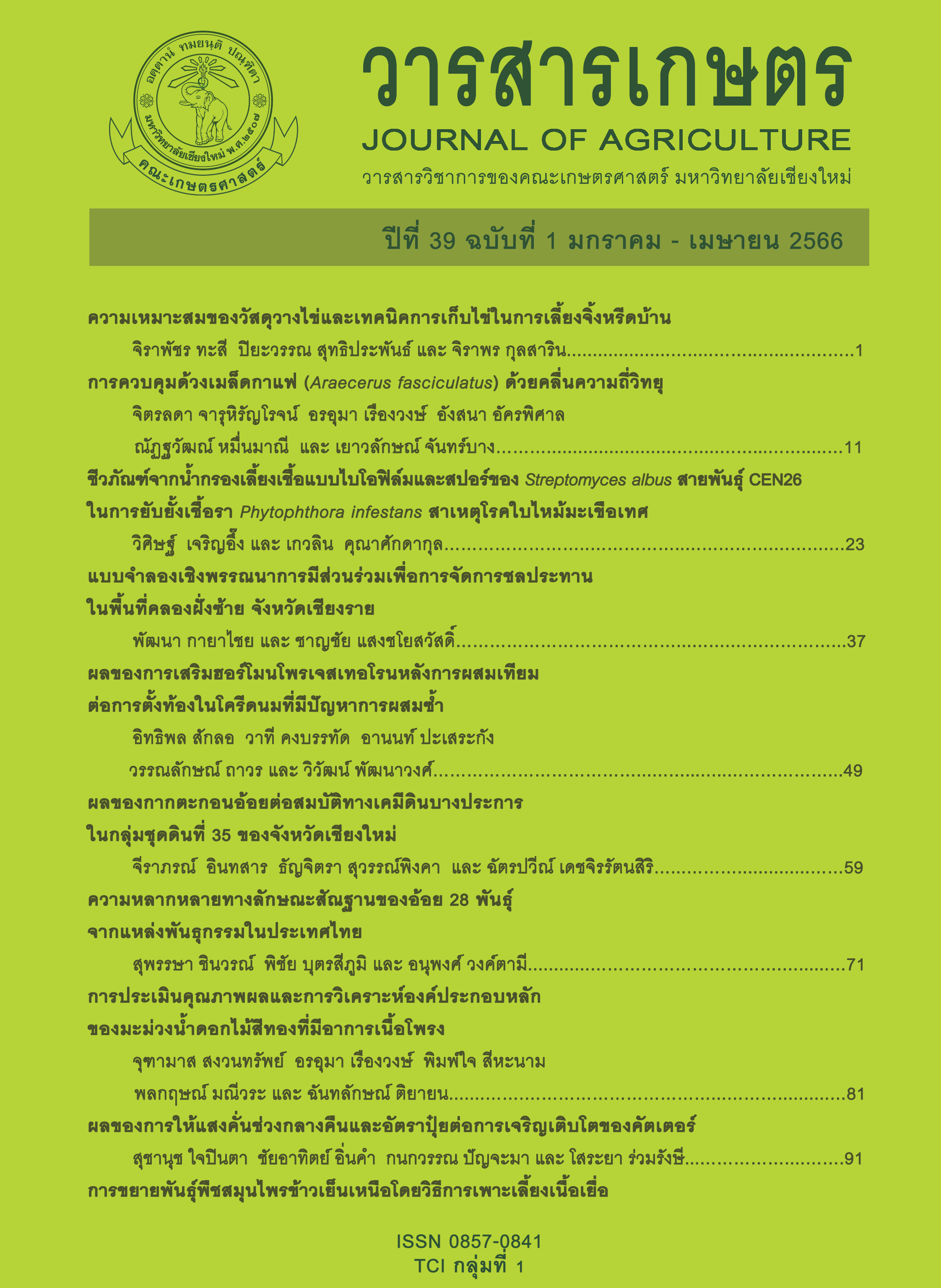Evaluation of Fruit Quality and Principal Component Analysis of Spongy Tissue Symptom in ‘Namdokmai Sithong’ Mango
Main Article Content
Abstract
Spongy tissue is one of a problem of 'Namdokmai Sithong' mango fruit quality. This experiment aimed to study the physical and chemical qualities of 'Namdokmai Sithong' mango fruit with spongy tissue symptoms. The experiment was carried out using a completely randomized design (CRD). Mango flesh was divided into four groups; 1) healthy tissue from healthy fruit (HTH), 2) healthy tissue from spongy tissue fruit (HTS), 3) tissue near spongy tissue (TNS), and 4) spongy tissue (ST). The results showed that ST had lightness, chroma, hue angle, total soluble solids (TSS), and titratable acidity (TA) lower than HTH and HTS. The ST fruit had the highest dry weight, TSS/TA, and phenolic compound. Principal component analysis (PCA) revealed that physical quality parameters in ST were clearly separated. The PC1 and PC2 could explain the main variations of data achieving 77.6 %. Chemical quality parameters of HTH and HTS were not separated. Therefore, spongy tissue had no impact on chemical qualities of healthy tissue from spongy tissue fruit.
Article Details

This work is licensed under a Creative Commons Attribution-NonCommercial-NoDerivatives 4.0 International License.
References
AOAC. 2000. Official Methods of Analysis of AOAC International. 17th ed. AOAC, Washington, D.C.
Chantrasri, P. 2013. Diseases and disorders. pp. 267-288. In: T. Radanachaless, W. Kumpoun and T. Jaroenkit (eds.). Mango Production and Postharvest Technology. Postharvest Technology Innovation Center, Chiang Mai. (in Thai)
de Oliveira Lima, L.C., A.B. Chitarra, M.I.F. Chitarra and E.B. Silva. 1999. Enzymatic activity changes in spongy tissue: a physiological ripening disorder of ‘Tommy Atkins’ mango. Acta Horticulturae 485: 255-258.
Gunjate, R.T., B.P. Walimbe, B.P. Lad and V.P. Limaye. 1982. Development of internal breakdown in Alphonso mango by post harvest exposure of fruits to sunlight. Science and Culture 48(5): 188-190.
Gunjate, R.T., S.J. Tare, A.D. Rangawala and V.P. Limaye. 1979. Calcium content in Alphonso mango fruits in relation to occurrence of spongy tissue. Journal of Maharashtra Agricultural Universities 4(2): 159-161.
Joshi, G.D. and V.P. Limaye. 1986. Effects of tree location and fruit weight on spongy tissue occurence in Alphonso mango. Journal of Maharashtra Agricultural Universities 11: 104-109.
Katrodia, J.S. and I.K. Sheth. 1988. Spongy tissue development in mango fruit of cv. Alphonso in relation to temperature and its control. Acta Horticulturae 231: 827-834.
Mitra, S.K. and E.A. Baldwin. 1997. Mango. pp. 85-122. In: S.K. Mitra (ed.). Postharvest Physiology and Storage of Tropical and Subtropical Fruits. CAB International, Wallingford. 448 p.
Oak, P., A. Deshpande, A. Giri and V. Gupta. 2019. Metabolomic dynamics reveals oxidative stress in spongy tissue disorder during ripening of Mangifera indica L. fruit. Metabolites 9(11): 255, doi: 10.3390/metabo9110255.
Office of Agricultural Economics. 2020. Export. (Online). Available: http://impexp.oae.go.th/service/export.php (March 8, 2021). (in Thai)
Pithakpol, W. and N. Rattanapanone. 2013. Fruit ripening. pp. 75-94. In: T. Radanachaless, W. Kumpoun and T. Jaroenkit (eds.). Mango Production and Postharvest Technology. Postharvest Technology Innovation Center, Chiang Mai. (in Thai)
Pohsomboon, M. and T. Radanachaless. 2013. Commercial Thai mango cultivars. pp. 157-189. In: T. Radanachaless, W. Kumpoun and T. Jaroenkit (eds.). Mango Production and Postharvest Technology. Postharvest Technology Innovation Center, Chiang Mai. (in Thai)
Ranganna, S. 1986. Handbook of Analysis and Quality Control for Fruit and Vegetable Products. 2nd ed. Tata McGraw-Hill Publishing Co., Ltd., New Delhi. 1112 p.
Ravindra, V. 2015. Recent understanding of spongy tissue problem in 'Alphonso' mango - a review. Acta Horticulturae 1066: 169-175.
Ravindra, V. and S. Shivashankar. 2004. Spongy tissue in Alphonso mango - significance of in situ seed germination events. Current Science 87(8): 1045-1049.
Rumainum, I. M., K. Worarad, V. Srilaong and K. Yamane. 2018. Fruit quality and antioxidant capacity of six Thai mango cultivars. Agriculture and Natural Resources 52(2): 208-214.
Shivashankar, S. 2014. Physiological disorders of mango fruit. pp. 313-347. In: J. Janick (ed.). Horticultural Reviews: Volume 42. John Wiley & Sons, Inc., Hoboken.
Soto-Vaca, A., A. Gutierrez, J. N. Losso, Z. Xu and J. W. Finley. 2012. Evolution of phenolic compounds from color and flavor problems to health benefits. Journal of Agricultural and Food Chemistry 60(27): 658-6677.
Subramanyam, H., S. Krishnamurthy, N.V. Subhadra, V.B. Dalal, G.S. Randhawa and E.K. Chacko. 1971. Studies on internal breakdown, a physiological ripening disorder in Alphonso mango (Mangifera indica L.). Tropical Science 13(3): 203-210.
Trivedi, M.K., A. Branton, D. Trivedi, G. Nayak, S.C. Mondal and S. Jana. 2015. Morphological characterization, quality, yield and DNA fingerprinting of biofield energy treated alphonso mango (Mangifera indica L.). Journal of Food and Nutrition Sciences 3(6): 245-250.
Uthaibutra, J. and K. Whangchai. 2013. Pigments and fruit color changes. pp. 59-74. In: T. Radanachaless, W. Kumpoun and T. Jaroenkit (eds.). Mango Production and Postharvest Technology. Postharvest Technology Innovation Center, Chiang Mai. (in Thai)
Vasanthaiah, H.K.N., K.V. Ravishankar, P. Narayanaswamy and K.S. Shivashankara. 2008. Influence of temperature on spongy tissue formation in ‘Alphonso’ mango. International Journal of Fruit Science 8(3): 226-234.
Wasusri, T. 2013. Mango supply chain. pp. 681-686. In: T. Radanachaless, W. Kumpoun and T. Jaroenkit (eds.). Mango Production and Postharvest Technology. Postharvest Technology Innovation Center, Chiang Mai. (in Thai)


